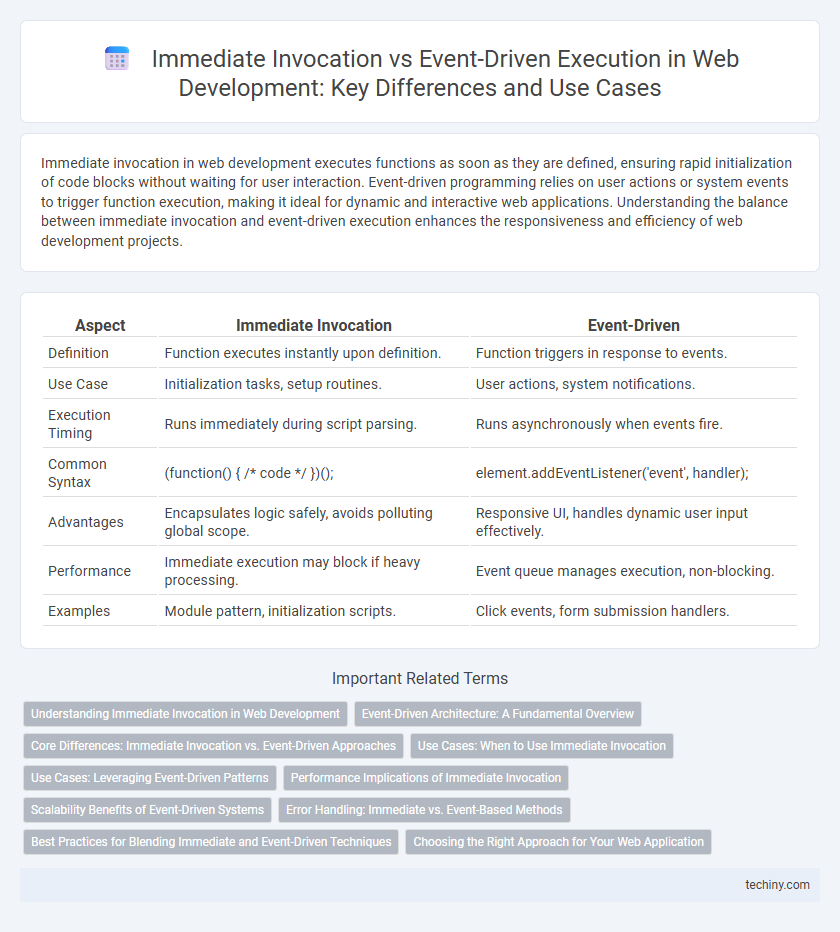Immediate invocation in web development executes functions as soon as they are defined, ensuring rapid initialization of code blocks without waiting for user interaction. Event-driven programming relies on user actions or system events to trigger function execution, making it ideal for dynamic and interactive web applications. Understanding the balance between immediate invocation and event-driven execution enhances the responsiveness and efficiency of web development projects.
Table of Comparison
| Aspect | Immediate Invocation | Event-Driven |
|---|---|---|
| Definition | Function executes instantly upon definition. | Function triggers in response to events. |
| Use Case | Initialization tasks, setup routines. | User actions, system notifications. |
| Execution Timing | Runs immediately during script parsing. | Runs asynchronously when events fire. |
| Common Syntax | (function() { /* code */ })(); | element.addEventListener('event', handler); |
| Advantages | Encapsulates logic safely, avoids polluting global scope. | Responsive UI, handles dynamic user input effectively. |
| Performance | Immediate execution may block if heavy processing. | Event queue manages execution, non-blocking. |
| Examples | Module pattern, initialization scripts. | Click events, form submission handlers. |
Understanding Immediate Invocation in Web Development
Immediate invocation in web development refers to functions executed instantly upon definition, often implemented using Immediately Invoked Function Expressions (IIFE) to create isolated scopes and prevent global namespace pollution. This technique enhances code modularity and protects variables from external interference, improving security and maintainability. Unlike event-driven approaches that rely on user interactions or system events to trigger functions, immediate invocation ensures immediate execution during script parsing and runtime initialization.
Event-Driven Architecture: A Fundamental Overview
Event-Driven Architecture (EDA) in web development centers on designing applications where components communicate through events, enabling asynchronous execution and improving scalability. Unlike immediate invocation patterns that execute functions instantly, EDA uses event emitters and listeners to trigger actions only when specific events occur, reducing resource consumption and enhancing responsiveness. Core components such as event producers, event channels, and event consumers collaborate to decouple system modules, fostering flexibility and real-time interaction in complex web applications.
Core Differences: Immediate Invocation vs. Event-Driven Approaches
Immediate invocation executes functions as soon as they are defined, ensuring synchronous processing and predictable flow, commonly seen in initialization tasks within web development. Event-driven approaches rely on user or system actions triggering functions asynchronously, promoting responsive and interactive web applications that handle dynamic content. Core differences include the timing and control of execution, with immediate invocation providing deterministic behavior, while event-driven methods enable scalable, real-time user engagement.
Use Cases: When to Use Immediate Invocation
Immediate invocation suits scenarios requiring code execution as soon as a script loads, such as setting up module patterns or initializing configuration variables. It is ideal for encapsulating logic to avoid polluting the global scope while immediately running setup functions. Event-driven invocation is preferable for user interactions or asynchronous events, but immediate invocation ensures deterministic execution during page load or module initialization.
Use Cases: Leveraging Event-Driven Patterns
Event-driven patterns in web development excel in scenarios requiring real-time user interactions, asynchronous data fetching, and dynamic content updates, providing responsive and scalable applications. Immediate invocation suits initialization tasks such as setup configurations and module encapsulation, ensuring code runs once without polluting the global scope. Leveraging event-driven architectures optimizes performance in complex applications by decoupling components, enabling efficient handling of user inputs, server responses, and system events.
Performance Implications of Immediate Invocation
Immediate invocation in web development triggers functions as soon as they are defined, reducing latency by executing code without waiting for user interaction or external events. This approach enhances performance in scenarios requiring instant calculations or setups, minimizing idle time and improving responsiveness. However, careless use can increase CPU usage unnecessarily, impacting overall efficiency compared to event-driven models that activate functions only upon specific triggers.
Scalability Benefits of Event-Driven Systems
Event-driven systems enhance scalability by decoupling components, allowing asynchronous processing and efficient resource utilization under varying loads. Immediate invocation triggers operations synchronously, often causing bottlenecks and limiting system responsiveness. By embracing event-driven architecture, web applications can dynamically scale to handle high concurrency and improve overall performance.
Error Handling: Immediate vs. Event-Based Methods
Immediate invocation methods catch and handle errors synchronously, allowing for quick identification and resolution during execution, which is crucial for debugging in web development. Event-driven error handling relies on asynchronous event listeners to detect and respond to errors, enhancing user experience by preventing application crashes and enabling recovery without interrupting the main thread. Combining both approaches improves robustness by addressing errors both in real-time and within event lifecycles, optimizing fault tolerance in complex web applications.
Best Practices for Blending Immediate and Event-Driven Techniques
Effective web development blends immediate invocation with event-driven techniques by invoking critical initialization functions instantly to establish necessary states and resources. Event listeners should be strategically attached to optimize responsiveness without blocking the main thread, ensuring seamless user interactions and performance. Prioritizing asynchronous execution and modular code structure enhances maintainability and scalability in complex web applications.
Choosing the Right Approach for Your Web Application
Immediate invocation executes functions as soon as they are defined, ensuring fast initialization and reducing wait times for essential scripts in web applications. Event-driven approaches trigger functions in response to user actions or system events, promoting responsiveness and efficient resource use by running code only when necessary. Selecting the right method depends on application requirements: immediate invocation suits setup tasks needing quick execution, while event-driven models enhance interactivity and scalability for dynamic user experiences.
immediate invocation vs event-driven Infographic

 techiny.com
techiny.com